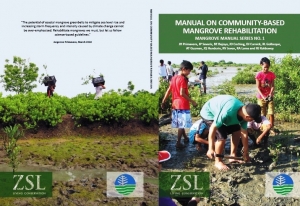New manual on mangroves promotes community-based restoration
The Mangrove Specialist Group of IUCN's Species Survival Commission and researchers from Zoological Society of London (Philippines) release electronic version of manual for wider access
Location: Iloilo, Philippines. 21st Feb 2014
The Community-based Mangrove Rehabilitation Project of ZSL ran from 2008 to 2012 with the aim of increasing coastal protection, food resources and livelihood income of coastal communities in Panay and Guimaras islands, Philippines. The project's main strategy was to rehabilitate abandoned government-leased fishponds to mangroves, re-establishing legally mandated coastal greenbelts, and securing tenure on coastal land through Community-based Forest Management Agreements (CBFMAs).
The ZSL-Philippines project organised the rearing of approximately 58,000 seedlings of a dozen mangrove species in onsite nurseries, and the outplanting of close to 100,000 wildings and nursery seedlings by some 4,000 volunteers from people's organizations, NGOs, professional organizations and church groups, students and teachers.
As interest in rehabilitating mangroves grows in the wake of the devastation from super typhoon Yolanda (international name: Haiyan), ZSL-Philippines is proud to announce that the manual is online and available to anyone with internet access.
The manual lists "20 Golden Rules of mangrove rehabilitation" and provides a comprehensive introduction to mangroves and management schemes in the Philippines. The manual also provides a step-by-step guide in establishing a mangrove nursery; outplanting mangroves; and organizing communities for sustainable management of newly-rehabilitated mangrove areas. Biophysical and sociopolitical lessons on mangrove conservation and planting are well-documented in the manual, which came out in print 2013.
The manual is recognized by the IUCN Species Survival Commission's Mangrove Specialist Group, that supports mangrove research and conservation projects by bringing together experts in the field to share their knowledge. The Mangrove Specialist Group's primary goals are: assess the conservation status of mangroves; identify, quantify and prioritise threats; and develop plans to conserve the most threatened species and habitats. In 2013, MFF and the IUCN Mangrove Specialist Group began working together and committed to share new information and knowledge related to mangrove conservation and management.
The Manual on Community-Based Mangrove Rehabilitation is available for public access from the Zoological Society of London's website.
For more information, please contact the ZSL-Philippines team through louise.baldwin@zsl.org and iucn-mangrove-specialist-group@googlegroups.com.

Manual on community-based mangrove restoration, Philippines © ZSL-Philippines, 2013